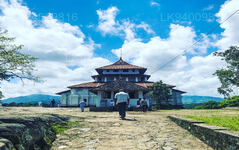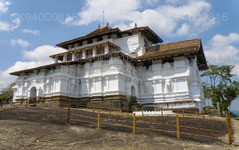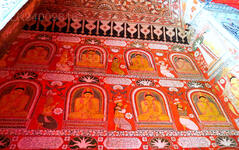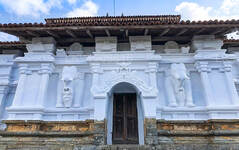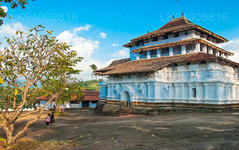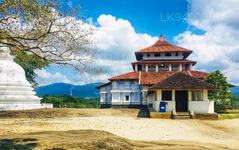
Kandy City
Kandy, a picturesque city in central Sri Lanka, is renowned for its rich cultural heritage, vibrant festivals, and scenic beauty. Nestled amidst lush hills, it is home to the Temple of the Tooth Relic, a UNESCO World Heritage Site, and offers a captivating blend of history and natural splendor.
ランカティラカ ヴィハラヤ
スリランカのランカティラカ ヴィハラヤ: 王の大寺院
ランカティラカは、スリランカのキャンディ地区のウドゥ ヌワラ地区のヒヤラピティヤ村にある 14 世紀の仏教寺院です。この歴史ある寺院は、西暦 1344 年にガンポラ王、ブワネカバフ 4 世王 (西暦 1341 ~ 1351 年) によって建てられました。ガンポラはマハベリ川のほとりにある要塞でした。
スリランカのランカティラカ ヴィハラヤ: 建築上の事実
- この寺院は南インドの建築家スタパティ・ラヤールによって設計されました。
- 研究者の意見によると;この寺院は、ポロンナルワ時代の建築のデザイン要素と、ドラヴィダ (インド) およびインドシナのデザイン要素を組み合わせています。建設当時、寺院は高さ 80 フィートの 4 階建ての建物で、花崗岩をベースにした基礎を使用して凹凸のある岩盤の上に建てられました。
- 神殿の構造は、中心から十字のように四方に放射状に広がっています。現在は、元の寺院の 1 階と 1 階の一部だけを見ることができますが、寺院は外から見ると 3 階建てに見えます。
- 神殿の厚い外壁には、美しく彫刻されたアーチやさまざまな彫刻があり、14 世紀のユニークなデザインとなっています。
スリランカのランカティラカ ヴィハラヤ: 寺院に入る際の見どころ
- お寺への参道は二方向あります。そのうちの 1 つは、岩のふもとに僧侶の住居があります。
- 敷地内には、地元の人々から「アトゥワ」と呼ばれる巨大な米びつなどの見どころもたくさんあります。階段は住居の敷地内から始まります。
- もう一つのアプローチは寺院の西側からです。
- 2 つのアプローチ方法があるため、2 つの異なる階段が登場します。 1 つは 14 世紀に建造されたオリジナルの飛行機で、もう 1 つはより最近のものです。階段はパハンガラの生きた岩に刻まれており、登る人に周囲の田園地帯の美しい景色を提供します。
- 古い階段を上ると、3 つの長い岩を貼り合わせて作られた原始的な石造りのドア アーチを通って寺院の敷地内に入ることができます。
スリランカのランカティラカ ヴィハラヤ: 寺院
寺院の敷地内には 3 つの区域があります。実際の寺院の建物、ダゴバまたは仏塔、そして最後にボーの木です。
階段のような寺院には 2 つの入り口があり、同じ建物内の 2 つの異なる分断されたセクションにつながっています。主要かつ最も重要な部門は東のセクションである仏像館です。もう一つは西にある神々の神殿です。
仏像館
- 東の入り口からアプローチし、東側の階段のすぐ前にある仏像館。入り口前の地面にはムーンストーンが飾られています。
- デフ。ムーンストーン: ほとんどの歴史的な仏教建築の階段のふもとにある半円形の石。
- ガジャシーニャ、つまり象頭のライオンのハイブリッド デザインが彫られた 2 つの欄干が、寺院の入り口のアーチ道に続く短い階段の脇にあります。
- 外側のアーチ道には、通常のマカラ トラナとは異なるいくつかのユニークな特徴を持つマカラ トラナまたはドラゴンの像があります。
- アーチ道の広い内側の側壁には、素晴らしく保存されたライオンの絵画が展示されています。木製のドアの近くに一対の守護者の彫像が立っており、そのドアにはツタやさまざまなデザインが描かれたいくつかのパネルが付いています。
- 仏像館の内部は、壁と天井が寺院建設当時の美しい絵画で埋め尽くされており、その全体が芸術の傑作です。
- 使用される顔料は主に赤、白、黄、黒です。おそらく黄土色が時の荒廃に耐えることができる顔料だったため、赤が優勢な色でした。
- 壁には24仏の生涯が描かれ、天井には抽象的な花の模様が描かれています。
- 仏像館の目玉は、美しい金色の仏陀坐像です。像の上には天使の彫刻が見守る別のマカラ トラナがあります。
スリランカのランカティラカ ヴィハラヤ: 岩の碑文
境内には岩肌に刻まれた文字が刻まれています。碑文はシンハラ語とタミル語の両方であり、その土地が王から寺院に贈られたものであり、寺院に提供されたその他の施設についても説明されています。
ランカティラカ寺院はスリランカの美しい文化遺産であり、休暇中にぜひ訪れてください。この寺院は、エンベッケ寺院と並んで、ガンポラ王国時代の最も先進的な建築物の 1 つとして残っています。
About Kandy District
Kandy district is situated in the centrel province of Sri Lanka. One of the seven World Heritage Sites in Sri Lanka, Kandy was once home to the Kandyan Kings of yore in the 16th-century and a fountainhead for all the music, arts, crafts and culture in the country. About 129 km away from Colombo, Kandy is ensconced amongst a hilly terrain and all eyes are drawn to the centre of the city, where the Kandy Lake forms a charming feature. Kandy retains great religious significance for Sri Lanka, because it is in this charming city that the Dalada Maligawa or "Temple of the Tooth" is located, within which the sacred tooth relic of Lord Buddha lies well guarded.
The Royal Botanical Garden, Peradeniya is situated about 5 km to the west of the city centre at Peradeniya and is visited by 1.2 million people per year. It is the largest botanical garden on the island. The Udawatta Kele (Udawatta Forest) is a protected sanctuary situated in the heart of the city, just north of Temple of the Tooth.
Kandy is a Sinhala majority city; there are sizeable communities belonging to other ethnic groups, such as Moors and Tamils. Kandy is second only to Colombo the center of the Sri Lankan Economy. Many major co operations have large branch officers in Kandy and many industries include textiles, furniture, Information Technology and jewellery are found here. Many agriculture research centers are located in the city.
And a fountainhead for all the music, arts, crafts and culture in the country. About 129 km away from Colombo, Kandy is ensconced amongst a hilly terrain and all eyes are drawn to the centre of the city, where the Kandy Lake forms a charming feature. Kandy retains great religious significance for Sri Lanka , because it is in this charming city that the Dalada Maligawa or Temple of the Toothis located, within which the sacred tooth relic of Lord Buddha lies well guarded.
About Central Provincce
The Central Province of Sri Lanka consists primarily of mountainous terrain. The province has an area of 5,674 km², and a population of 2,421,148. Some major towns include Kandy, Gampola (24,730), Nuwara Eliya and Bandarawela. The population is a mixture of Sinhalese, Tamil and the Moors.
Both the hill capital Kandy and the city of Nuwara Eliya are located within the Central Province as well as Sri Pada. The province produces much of the famous Ceylon tea, planted by the British in the 1860s after a devastating disease killed all the coffee plantations in the province. Central Province attracts many tourists, with hill station towns such as Kandy, Gampola, Hatton and Nuwara Eliya. Temple tooth or Dalada maligawa is the main sacred place in Centrel province.
The climate is cool, and many areas about 1500 meters often have chilly nights. The western slopes are very wet, some places having almost 7000 mm of rain per year. The eastern slopes are parts of the mid-dry zone as it is receiving rain only from North-Eastern monsoon. The Temperatures range from 24°C at Kandy to just 16°C in Nuwara Eliya, which is located 1,889 m above sea level. The highest mountains in Sri Lanka are located in the Central Province. The terrain is mostly mountainous, with deep valleys cutting into it. The two main mountain regions are the central massif and the Knuckles range to the east of Kandy.

